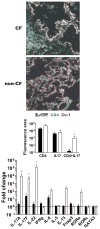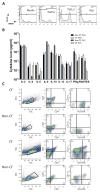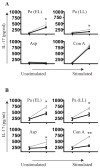Patients with cystic fibrosis have inducible IL-17+IL-22+ memory cells in lung draining lymph nodes
- PMID: 22795370
- PMCID: PMC3488163
- DOI: 10.1016/j.jaci.2012.05.036
Patients with cystic fibrosis have inducible IL-17+IL-22+ memory cells in lung draining lymph nodes
Abstract
Background: IL-17 is an important cytokine signature of the TH differentiation pathway TH17. This T-cell subset is crucial in mediating autoimmune disease or antimicrobial immunity in animal models, but its presence and role in human disease remain to be completely characterized.
Objective: We set out to determine the frequency of TH17 cells in patients with cystic fibrosis (CF), a disease in which there is recurrent infection with known pathogens.
Methods: Explanted lungs from patients undergoing transplantation or organ donors (CF samples=18; non-CF, nonbronchiectatic samples=10) were collected. Hilar nodes and parenchymal lung tissue were processed and examined for TH17 signature by using immunofluorescence and quantitative real-time PCR. T cells were isolated and stimulated with antigens from Pseudomonas aeruginosa and Aspergillus species. Cytokine profiles and staining with flow cytometry were used to assess the reactivity of these cells to antigen stimulation.
Results: We found a strong IL-17 phenotype in patients with CF compared with that seen in control subjects without CF. Within this tissue, we found pathogenic antigen-responsive CD4+IL-17+ cells. There were double-positive IL-17+IL-22+ cells [TH17(22)], and the IL-22+ population had a higher proportion of memory characteristics. Antigen-specific TH17 responses were stronger in the draining lymph nodes compared with those seen in matched parenchymal lungs.
Conclusion: Inducible proliferation of TH17(22) with memory cell characteristics is seen in the lungs of patients with CF. The function of these individual subpopulations will require further study regarding their development. T cells are likely not the exclusive producers of IL-17 and IL-22, and this will require further characterization.
Copyright © 2012 American Academy of Allergy, Asthma & Immunology. Published by Mosby, Inc. All rights reserved.
Figures








 ) and compared to no neutralization (—) with 20 μg/ml of IgG. (B) IL-13 and IFNγ were also neutralized (n = 3).. * p < 0.05, ** p < 0.001
) and compared to no neutralization (—) with 20 μg/ml of IgG. (B) IL-13 and IFNγ were also neutralized (n = 3).. * p < 0.05, ** p < 0.001Similar articles
-
Scnn1b-Transgenic BALB/c Mice as a Model of Pseudomonas aeruginosa Infections of the Cystic Fibrosis Lung.Infect Immun. 2020 Aug 19;88(9):e00237-20. doi: 10.1128/IAI.00237-20. Print 2020 Aug 19. Infect Immun. 2020. PMID: 32631918 Free PMC article.
-
A Th17- and Th2-skewed cytokine profile in cystic fibrosis lungs represents a potential risk factor for Pseudomonas aeruginosa infection.Am J Respir Crit Care Med. 2013 Mar 15;187(6):621-9. doi: 10.1164/rccm.201206-1150OC. Epub 2013 Jan 10. Am J Respir Crit Care Med. 2013. PMID: 23306544
-
Intrinsic predisposition of naïve cystic fibrosis T cells to differentiate towards a Th17 phenotype.Respir Res. 2013 Dec 17;14(1):138. doi: 10.1186/1465-9921-14-138. Respir Res. 2013. PMID: 24344776 Free PMC article.
-
Is cystic fibrosis a TH17 disease?Inflamm Res. 2007 Jun;56(6):221-7. doi: 10.1007/s00011-007-6187-2. Inflamm Res. 2007. PMID: 17607545 Review.
-
Th17 cell development: from the cradle to the grave.Immunol Rev. 2013 Mar;252(1):78-88. doi: 10.1111/imr.12036. Immunol Rev. 2013. PMID: 23405896 Review.
Cited by
-
Host-pathogen interplay in the respiratory environment of cystic fibrosis.J Cyst Fibros. 2015 Jul;14(4):431-439. doi: 10.1016/j.jcf.2015.02.008. Epub 2015 Mar 19. J Cyst Fibros. 2015. PMID: 25800687 Free PMC article. Review.
-
Granulocyte-macrophage colony stimulatory factor enhances the pro-inflammatory response of interferon-γ-treated macrophages to Pseudomonas aeruginosa infection.PLoS One. 2015 Feb 23;10(2):e0117447. doi: 10.1371/journal.pone.0117447. eCollection 2015. PLoS One. 2015. PMID: 25706389 Free PMC article.
-
The Double Game Played by Th17 Cells in Infection: Host Defense and Immunopathology.Pathogens. 2022 Dec 15;11(12):1547. doi: 10.3390/pathogens11121547. Pathogens. 2022. PMID: 36558881 Free PMC article. Review.
-
Interleukin-17 in Antifungal Immunity.Pathogens. 2019 Apr 22;8(2):54. doi: 10.3390/pathogens8020054. Pathogens. 2019. PMID: 31013616 Free PMC article. Review.
-
Streptomycin treatment alters the intestinal microbiome, pulmonary T cell profile and airway hyperresponsiveness in a cystic fibrosis mouse model.Sci Rep. 2016 Jan 12;6:19189. doi: 10.1038/srep19189. Sci Rep. 2016. PMID: 26754178 Free PMC article.
References
-
- Mosmann TR, Cherwinski H, Bond MW, Giedlin MA, Coffman RL. Two types of murine helper T cell clone. I. Definition according to profiles of lymphokine activities and secreted proteins. J Immunol. 1986;136:2348–57. - PubMed
-
- Yao Z, Fanslow WC, Seldin MF, Rousseau AM, Painter SL, Comeau MR, et al. Herpesvirus Saimiri encodes a new cytokine, IL-17, which binds to a novel cytokine receptor. Immunity. 1995;3:811–21. - PubMed
-
- Yao Z, Painter SL, Fanslow WC, Ulrich D, Macduff BM, Spriggs MK, et al. Human IL-17: a novel cytokine derived from T cells. J Immunol. 1995;155:5483–6. - PubMed
-
- Rouvier E, Luciani MF, Mattei MG, Denizot F, Golstein P. CTLA-8, cloned from an activated T cell, bearing AU-rich messenger RNA instability sequences, and homologous to a herpesvirus saimiri gene. J Immunol. 1993;150:5445–56. - PubMed
Publication types
MeSH terms
Substances
Grants and funding
LinkOut - more resources
Full Text Sources
Other Literature Sources
Medical
Research Materials

